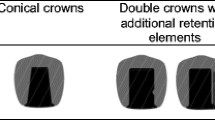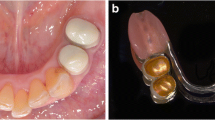Abstract
Objectives
The aim of this study was to evaluate the retention forces (RFs) of zirconia double-crown systems, with primary and secondary crowns made from zirconia in vitro.
Materials and methods
Ten maxillary models with six abutment teeth were prepared. Sixty inner crowns were fabricated from pre-sintered zirconia with a taper of 0°. Ten 14-unit telescopic prostheses (removable partial dentures, RDPs) were fabricated, using the same computer-aided design/computer-aided manufacturing system as that used for the inner crowns. The removal test was performed in a standardized setup using a universal testing device at a crosshead speed of 10 mm/min. Ten separation cycles were carried out for each single primary crown as well as for each 14-unit RDP in the presence of artificial saliva. The results were imported into a statistic program and analysed by a one-way ANOVA and post hoc tests. The level of significance was set at 5 %.
Results
The mean RFs of the single double-crown systems were in the range of 0.611–2.895 N, whereas the RFs for the whole RDP varied between 8.1 and 13.6 N. RF was dependent on the abutment tooth (p < 0.001) and on the model (p < 0.001).
Conclusions
The results of this study indicate that the manufacturing of full-zirconia double-crown systems is possible as well as reproducible. The RFs are comparable to those reported from casted and electroformed double-crown systems.
Clinical relevance
It has been shown that the RFs of the presented telescopic system are comparable to existing double-crown systems.





Similar content being viewed by others
References
Perel ML (1973) Telescope dentures. J Prosthet Dent 29:151–156
Weigl P, Lauer HC (2000) Advanced biomaterials used for a new telescopic retainer for removable dentures. J Biomed Mater Res 53:337–347
Behr M, Hofmann E, Rosentritt M, Lang R, Handel G (2000) Technical failure rates of double crown-retained removable partial dentures. Clin Oral Investig 4:87–90
Hummel SK, Wilson MA, Marker VA, Nunn ME (2002) Quality of removable partial dentures worn by the adult U.S. population. J Prosthet Dent 88:37–43
Inukai M, Baba K, John MT, Igarashi Y (2008) Does removable partial denture quality affect individuals’ oral health? J Dent Res 87:736–739
Hofmann E, Behr M, Handel G (2002) Frequency and costs of technical failures of clasp- and double crown-retained removable partial dentures. Clin Oral Investig 6:104–108
Weigl P, Hahn L, Lauer HC (2000) Advanced biomaterials used for a new telescopic retainer for removable dentures. J Biomed Mater Res 53:320–336
Koller B, Att W, Strub JR (2011) Survival rates of teeth, implants, and double crown-retained removable dental prostheses: a systematic literature review. Int J Prosthodont 24:109–117
Schunke S (2007) Prinzipielle Funktionsweisen der Doppelkronensysteme. Quintessence Zahntechnik 12:1496–1507
Beuer F, Steff B, Naumann M, Sorensen JA (2008) Load-bearing capacity of all-ceramic three-unit fixed partial dentures with different computer-aided design (CAD)/computer-aided manufacturing (CAM) fabricated framework materials. Eur J Oral Sci 116:381–386
Beuer F, Schweiger J, Edelhoff D (2008) Digital dentistry: an overview of recent developments for CAD/CAM generated restorations. Br Dent J 204:505–511
Beuer F, Aggstaller H, Edelhoff D, Gernet W, Sorensen J (2009) Marginal and internal fits of fixed dental prostheses zirconia retainers. Dent Mater 25:94–102
Abduo J, Lyons K, Swain M (2010) Fit of zirconia fixed partial denture: a systematic review. J Oral Rehabil 37:866–876
Bindl A, Mormann WH (2005) Marginal and internal fit of all-ceramic CAD/CAM crown-copings on chamfer preparations. J Oral Rehabil 32:441–447
Schmitter M, Mussotter K, Rammelsberg P, Gabbert O, Ohlmann B (2012) Clinical performance of long-span zirconia frameworks for fixed dental prostheses: 5-year results. J Oral Rehabil 39:552–557
Choi YS, Kim SH, Lee JB, Han JS, Yeo IS (2012) In vitro evaluation of fracture strength of zirconia restoration veneered with various ceramic materials. J Adv Prosthodont 4:162–169
Chaar MS, Witkowski S, Strub JR, Att W (2013) Effect of veneering technique on the fracture resistance of zirconia fixed dental prostheses. J Oral Rehabil 40:51–59
Quinn GD, Studart AR, Hebert C, VerHoef JR, Arola D (2010) Fatigue of zirconia and dental bridge geometry: design implications. Dent Mater 26:1133–1136
Salazar Marocho SM, Studart AR, Bottino MA, Bona AD (2010) Mechanical strength and subcritical crack growth under wet cyclic loading of glass-infiltrated dental ceramics. Dent Mater 26:483–490
Studart AR, Filser F, Kocher P, Gauckler LJ (2007) Fatigue of zirconia under cyclic loading in water and its implications for the design of dental bridges. Dent Mater 23:106–114
Studart AR, Filser F, Kocher P, Luthy H, Gauckler LJ (2007) Cyclic fatigue in water of veneer-framework composites for all-ceramic dental bridges. Dent Mater 23:177–185
Stawarczyk B, Ozcan M, Roos M, Trottmann A, Hammerle CH (2011) Fracture load and failure analysis of zirconia single crowns veneered with pressed and layered ceramics after chewing simulation. Dent Mater J 30:554–562
Stawarczyk B, Ozcan M, Schmutz F, Trottmann A, Roos M, Hammerle CH (2013) Two-body wear of monolithic, veneered and glazed zirconia and their corresponding enamel antagonists. Acta Odontol Scand 71:102–112
Rojas-Vizcaya F (2011) Full zirconia fixed detachable implant-retained restorations manufactured from monolithic zirconia: clinical report after two years in service. J Prosthodont 20:570–576
Beuer F, Edelhoff D, Gernet W, Naumann M (2010) Parameters affecting retentive force of electroformed double-crown systems. Clin Oral Investig 14:129–135
Beuer F, Aggstaller H, Edelhoff D, Gernet W (2008) Effect of preparation design on the fracture resistance of zirconia crown copings. Dent Mater J 27:362–367
Bayer S, Stark H, Mues S, Keilig L, Schrader A, Enkling N (2010) Retention force measurement of telescopic crowns. Clin Oral Investig 14:607–611
Bayer S, Kraus D, Keilig L, Golz L, Stark H, Enkling N (2012) Wear of double crown systems: electroplated vs. casted female part. J Appl Oral Sci 20:384–391
Engels J, Schubert O, Guth JF, Hoffmann M, Jauernig C, Erdelt K, Stimmelmayr M, Beuer F (2012) Wear behavior of different double-crown systems. Clin Oral Investig 17:503–510
Beuer F, Edelhoff D, Gernet W, Sorensen JA (2009) Three-year clinical prospective evaluation of zirconia-based posterior fixed dental prostheses (FDPs). Clin Oral Investig 13:445–451
Beuer F, Schweiger J, Eichberger M, Kappert HF, Gernet W, Edelhoff D (2009) High-strength CAD/CAM-fabricated veneering material sintered to zirconia copings—a new fabrication mode for all-ceramic restorations. Dent Mater 25:121–128
Ozcan M, Valandro LF, Pereira SM, Amaral R, Bottino MA, Pekkan G (2013) Effect of surface conditioning modalities on the repair bond strength of resin composite to the zirconia core/veneering ceramic complex. J Adhes Dent 15:207–210
Schweiger J, Neumeier P, Stimmelmayr M, Beuer F, Edelhoff D (2013) Macro-retentive replaceable veneers on crowns and fixed dental prostheses: a new approach in implant-prosthodontics. Quintessence Int 44:341–349
Nelson K, Hildebrand D, Mehrhof J (2008) Fabrication of a fixed retrievable implant-supported prosthesis based on electroforming: a technical report. J Prosthodont 17:591–595
Acknowledgments
The authors wish to thank Enrico Steger (Zirkonzahn, Gais, Südtirol, Italy) for supporting the study with the milling unit M5 and all necessary materials. The authors would like to sincerely thank Josef Schweiger (head of the dental laboratory) for his assistance whenever technical problems had to be resolved.
Conflict of interest
The authors declare that they have no conflict of interest.
Author information
Authors and Affiliations
Corresponding author
Rights and permissions
About this article
Cite this article
Groesser, J., Sachs, C., Heiß, P. et al. Retention forces of 14-unit zirconia telescopic prostheses with six double crowns made from zirconia—an in vitro study. Clin Oral Invest 18, 1173–1179 (2014). https://doi.org/10.1007/s00784-013-1093-1
Received:
Accepted:
Published:
Issue Date:
DOI: https://doi.org/10.1007/s00784-013-1093-1




